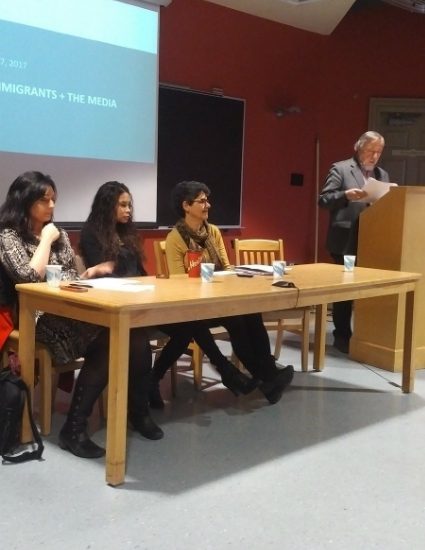Kjipuktuk (Halifax) – Stereotypes, ignorance and bias are very much part of the way many of Nova Scotia’s reporters tell the stories of African Nova Scotians, Mi’kmaq people and immigrants.
By and large that was the consensus that emerged during a well-attended panel discussion at the University of King’s College last Friday.
Poet and writer El Jones, Mi’kmaw lawyer and professor Naiomi Metallic and Nabiha Atallah, who works for the Immigrant Services of Nova Scotia (ISANS) all offered their views.

A lot of ground was covered, and there is no way a brief report can even begin to reflect all that was said. The panel discussion was recorded, and will be posted online. Get curious and check it out, probably on this website. Or maybe here.
Not all immigrant success stories are economic success stories
Allow immigrants tell their own story, said Atallah, who on the whole was pleased with the way the arrival of Syrian refugees last year was covered in the media.
That said, there was also the infamous story published in the scab Chronicle Herald, full of stereotypes and unsubstantiated allegations.
“We’re often asked for success stories at ISANS, and we are happy to share, but when people talk about success they often mean economic success. That’s not the only measure of success and we would like to see a broader perspective,” said Atallah.
Not all immigrants are from Syria, and some segments of the immigrant community are consistently ignored by the media.
“Immigrants with disabilities are absent in the entire narrative about immigration. But they are there, and they are amazing people with a lot of resilience,” Natillah observed.
It’s about the problem of Black people living and breathing
EL Jones looked at the recent reporting on carding, that disproportionately affects African Nova Scotians. There is something much bigger going on, Jones suggested.
“We are not considered to be equally human in any way,” said Jones.
“When we look at the criminalization of black people it is in the context of a long and deliberate history of dehumanizing Black people and their lives. This is not solely about policing, in fact it is not primarily about policing, it’s about the problem of Black people living and breathing and being on the street.”
As well, media are too quick to assume that the story as told by authorities and police is the only true version.
The fact is that journalists often rely on police accounts that are fundamentally flawed,” said Jones. “An example is the myth of North Preston’s Finest, a myth that has persisted for 30 years.”
“It doesn’t matter how much the people of North Preston say that of course there are these problems in the community, but a Canada-wide super organized gang constantly trafficking people, that’s just false to us. But that doesn’t seem to matter because the police insists on it.”
“The media significantly shapes public opinion about indigenous people”
Naiomi Metallic tackled a variety of pervasive myths about indigenous communities.
Incompetent chiefs and band councils wasting taxpayers’ money, entitled indigenous communities living the good life because of all the government handouts, we’ve all heard it before.
All these narratives are clearly wrong and easily disproved.
“Then there is what I call the narrative of despair,” said Metallic. “Talking about the poverty, but never talking about the historic and contemporary sources of underfunding. Never talking about solutions. Solutions don’t seem to get the same air time.”
“The media has not been neutral in how it deals with indigenous people through history. The media has perpetuated colonial constructs about native inferiority. And that also contributes to the marginalization of indigenous peoples,” Metallic said.
All this really matters, said Metallic, “because the media significantly shapes public opinion about indigenous people, especially when other sources such as the public education system are lacking. The media has a huge impact on public opinion.”
Metallic also talked about the way Nova Scotia media covered the Cape Breton moose hunt this fall. That hunt in Cape Breton Highlands National Park was steeped in controversy.
There were confrontations between Mi’kmaw hunters and protesters, who claimed that the hunt constituted a threat to the moose population, contrary to what the Park’s ecologists had determined.
“The media focused on the voices of the non-aboriginal protesters, and if was only the APTN journalist (Trina Roache) talking to indigenous people and talking about treaty rights. Even when a Parks Canada person pointed them to a Mi’kmaq who had been very involved in the planning of the hunt they just walked away from that, they didn’t even bother to talk to him.”
At the time I was sufficiently pissed off to write my own op-ed about that controversy.
See also:
Weekend video: our rightful place (the Mi’kmaw perspective on the moose hunt)
It’s called carding, and it should stop entirely
Please support the Nova Scotia Advocate so that it can continue to cover issues such as poverty, racism, exclusion, workers’ rights and the environment in Nova Scotia.



